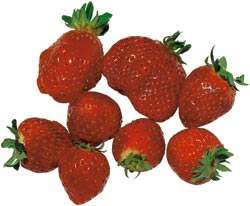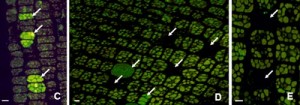From poison to palatable
Every night millions of people go to bed hungry. New genetic technology can help us feed the world by making inedible seeds more edible.
There are roughly about a quarter of a million plant species known on Earth. But we only eat between 5000 and 10 000 of them. Many are poisonous to us – such as lily of the valley. And many plants have no human nutritional value – such as grass.
“In fact, there are no more than about 100 known species that can be used as important food crops,” says Biology Professor Atle Bones at Norwegian University of Science and Technology.
But Bones and his research team have made a major discovery. They have figured out how a canola plant can be genetically programmed to reduce the toxic substances it produces in its seeds – thus making it more palatable.
Nobody has done this before, and Bones thinks it could be the beginning of a food revolution. “The principle could be used with other plant species and plant parts,” he says.
Tiny toxic bombs
Canola, or rape, is one of the fifteen most important crop plants in the world. It contains special cells that produce toxic substances. These “toxic bombs” are part of the plant’s defence system and are activated in specific situations – such as when an insect begins feeding on a leaf. The substance that is released burns like hot mustard, causing animals and insects to move away.
– “These ‘toxic bombs’ are good for the plant, but undesirable in animal feed and human food,” says Bones.
When canola seeds are pressed, all the vegetable oil is removed. What is left is a protein-rich flour that can be used in food for animals and humans. But if the seeds pressed in the wrong way, the plant responds by releasing its toxic compounds. The oil is then flavoured with a taste of strong mustard, and the animals that eat the protein flour have stomach problems and troubles with nutrient uptake.

Consumers should be allowed to choose whether they want to eat strawberries from normal strawberry fields sprayed with pesticides many times in a short summer, or genetically modified strawberries that are sprayed just a few times, says Biology Professor Atle Bones.
Photo: photos.com
The NTNU research group has genetically reprogrammed canola cells so that the toxic bomb cells disappear on their own as the seed matures. But the toxin only fully disappears in the mature seeds. This way, the plant can continue to protect itself, while the toxic compounds are removed from the part of the rapeseed used for food.
Thus, the proportion of rapeseed in the concentrate can be increased, and the seeds can be pressed without the risk of contaminating the oil with unwanted flavours and odours.
GMO production TO double
There are almost 7 billion people on Earth. Every day, 25 000 people die of malnutrition – while 800 million are starving. By 2050 there will be more than 9 billion of us. As people become more prosperous, their per-person calorie consumption will grow. This combination of increased prosperity and population growth means that food production will have to double by 2050.
Globally, genetically modified food in production is already cultivated on +130 million hectares. But Bones believes that the production of genetically modified plants will more than double over the next ten years.
“From the perspective of famine and drought, this technology has a lot going for it.”
Professor Bjørn Myskja
“Today there are 25 countries that use genetically modified plants on a large scale. More than 50 per cent of the world’s population lives in these countries. Genetically modified soy already represents 75 per cent of all soybean production. And genetically modified plants are grown in an area that is 40 times the size of Denmark – mainly in the USA, Argentina, Brazil and China,” Bones said.
Genetically modified food is grown in seven European countries. There is already super broccoli that contains higher doses of the healthy substances in normal broccoli. Next year, producers will introduce soybeans enriched with omega-3 fatty acids.
From marijuana to food
Among the plants that could be genetically modified by removing their undesirable chemicals is cannabis, Bones points out.
Cannabis is a type of grass that thrives in subtropical and dry climates – and is best known as the raw material for hashish and marijuana. But it is one of the world’s fastest growing plants, and is exceptionally hardy. Its plant fibres can be used for rope and textiles, or as replacements for trees in the paper industry because they are stronger than wood fibre. The seeds can be used for oil.
“It would be interesting to use our new technology to produce cannabis that does not contain the psychoactive substance THC,” Bones adds.
Banned in Norway
It is illegal to grow genetically modified food in Norway, and in principle it may not be imported – not even for animal feed. But there are cracks in this virtual barrier, and small traces of genetically modified food are seeping in. Because Norway does not allow the sales of goods containing genetically modified contents, there is no provision for labelling this food on the grocery store shelves. But it’s there.
The government has set 0.9 per cent as the ceiling for how much genetically modified food may be in foods before they must be labelled. Each year, the Norwegian Food Safety Authority finds genetically modified canola, corn or rice in imported foods, which are promptly branded as illegal immigrants and kicked out of the country.
But the test sample size is small – last year only 131 samples were tested, of which 4 contained genetically modified food.
According to the Norwegian Board of Technology, it is difficult to keep Norway completely free of genetically modified ingredients, which is why Norwegian law sets a limit of 0.9 per cent.
Molecular biology at NTNU
Research into cell biology started at NTNU's Department of Botany at the end of the 1960s, while the disciplines of molecular biology and genomics were established in1985 and 2000, respectively. Today's technology makes it possible to study the activity of thousands of genes, proteins and metabolites from the same biological sample.
The findings can be used for diagnosis, targeted changes of cells and organisms and the production of all kinds of things. In the future, the cellular, molecular and genomic group at NTNU will contribute to improved methods for environmental monitoring, production of vaccines, analysis of biodiversity, increased food security and bioenergy production.
Behind the scenes
Molecular biology at NTNU
Research into cell biology started at NTNU's Department of Botany at the end of the 1960s, while the disciplines of molecular biology and genomics were established in1985 and 2000, respectively. Today's technology makes it possible to study the activity of thousands of genes, proteins and metabolites from the same biological sample.
The findings can be used for diagnosis, targeted changes of cells and organisms and the production of all kinds of things. In the future, the cellular, molecular and genomic group at NTNU will contribute to improved methods for environmental monitoring, production of vaccines, analysis of biodiversity, increased food security and bioenergy production.
The Ministry of the Environment has had an application on the table for the last two years concerning the import of two types of GM maize. The Directorate for Nature Management said yes to the import the first time, the Norwegian Scientific Committee for Food Safety in Oslo also gave the proposal a thumbs up, while the Norwegian Biotechnology Advisory Board said no. In 2010, 19 different environment, solidarity and consumer organizations urged Environment Minister Erik Solheim to say no to the proposal.
“You may wonder why no decision has been taken yet. There isn’t a lot of public discussion about the proposal in Norway. But it is being discussed a great deal behind the scenes,” says Trine Magnus.
Magnus is a researcher at the Norwegian Centre for Rural Research, which works closely with NTNU. She will soon finish her doctoral thesis, which shows that Norwegians have changed their attitudes about genetically modified food from fear to scepticism. Older Norwegians are the most sceptical, while young people are more open to the idea.
A shift in attitudes
“Young people today have grown up in a world permeated by technology, and genetic engineering is not new. Therefore, they are not as afraid of it,” said Magnus.
“Ten years ago people were talking about Frankenstein food, and genetically altered food that had been fiddled with, altered and tinkered with. Now we see a shift in the discussion of genetically modified food to more neutral language. We talk about genetically modified food rather than using emotionally laden expressions. We also see a shift in Norwegians’ attitudes to genetically modified food when we put the questions into an environmental context. Norwegians are more supportive of the use of genetic engineering in agriculture if it is good for the environment. For example, if it means that you can eat strawberries that have been sprayed with less pesticides,” said Magnus.
Many researchers explain Norwegian scepticism as a lack of knowledge about genetically modified food. Magnus thinks it’s more about the lack of visible benefits and ethics. She believes there are already traces of genetically modified plants in animal feed.
“Felleskjøpet, the Norwegian Agricultural Purchasing and Marketing Co-Op, is finding it hard to get corn and soy that are not genetically modified, and procuring it involves a huge additional cost. It will first come to Norway in fish feed. In ten years time it is likely that we will find food containing genetically modified ingredients in Norwegian grocery stores,” said Magnus.
Everything is genetically modified
Atle Bones sees many benefits of genetically modified food.
“Genetically modified plants can be tailored to tolerate different climatic conditions such as drought or hard winters, and to have increased resistance to insects or fungus. These plants can thus be grown with fewer pesticides. This means that farmers are exposed to less pesticides, there are less pesticides in the ecosystem and probably less pesticides in food that is produced,” he notes.
“There is nothing wrong or unethical about using genetically modified plants – because, in fact, all crops are modified. They have also been created from wild plants through comprehensive human-controlled breeding programmes and genetic selection,” says Bones.

Making rapeseed non-toxic
The light green substance inside the rapeseed cell is an enzyme that forms toxic compounds naturally in the tissues of the plant. The compounds are part of the plant’s immune system and are activated in specific situations, such as when an insect starts feeding on a leaf.
The compound that is released burns, driving insects away. The researchers genetically reprogrammed the cells in the seed that contain the toxic compounds so that they destroy themselves when the seeds mature. The plant also maintains a normal immune system, while the seed – used for food – is free of the toxic compound.
Gain is too small
There are two camps in Norway when it comes to genetically modified food. Most of those who say yes are biologists. Most of those who say no are from the social sciences.
Bjørn Myskja, an associate professor of philosophy at NTNU, has written several articles on genetic modification and participated in an interdisciplinary project about genetically modified strawberries at the Plant Biocentre at NTNU.
He believes that the benefits are too limited for him to give a thumbs up to GM food:
“So far the focus has mostly been on plants where the need for pesticides has been decreased, or where the resistance to insects has increased. I believe that this gain is too small in relation to the risks that genetically modified plants may pose,” says Myskja.
The philosopher believes that the most important argument against genetically modified food is the risk of proliferation of artificial genes.
“It is well documented that genetically modified plants cross with wild plants and other crops. This spread may involve a danger to local ecosystems and agriculture, and perhaps even weaken the genetic diversity that we will depend on to grow food in the future. When this kind of proliferation begins, it can be difficult to stop. We might end up with plants that have qualities we do not want. The benefit is not great enough compared to the risk,” says Myskja.
A case-by-case basis
Myskja would like to see more research directed toward the big problems facing the world’s population, such as hunger and drought:
“From this perspective, this technology has merits. Scientists have promised for years that they will solve the world’s major food shortages, but we have yet to see any concrete examples. There is not very much research on this issue, and most of our research resources are used to study plants that are useful to western agriculture. This is a moral problem in the food industry, and many of the great promises that have been made about preventing famine are mostly to legitimize research to make the most profit out of supplying agriculture,” Myskja says.
“I do not want to reject this technology on principle alone, but I believe that one must examine each situation on a case-by-case basis, and consider what benefit will result from the use of this particular genetically modified plant and at what risk,” he adds.
Must be thoroughly tested
It is no longer possible in the United States to distinguish between ordinary food and genetically modified food. Some researchers describe the American situation as if people are playing Russian roulette with their health. Fear of allergies is one reason. Atle Bones believes that these kinds of worries over possible health effects are greatly exaggerated.
“It is obviously not possible to give an ironclad guarantee that no one will be allergic to a new gene in canola or corn. Neither is it possible to guarantee that no one is allergic to traditional modified plants. But this would normally be detected before the plants or the product goes into production. The method we have used, however, can remove known allergens, digestive inhibitory substances or toxins in the plant,” said Bones.
He also believes that genetically modified plants must be assessed in each situation, and like conventionally modified plants, be tested thoroughly before they are approved for production.
“With our new technology, it is possible to target changes in specific parts of the plant. It is therefore possible to change a strawberry plant without any change in the berry to be eaten. And that is a scientific breakthrough,” he says.
Anne Sliper Midling





